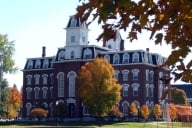You have /5 articles left.
Sign up for a free account or log in.
In a world where chain drug stores are on just about every other corner and prescription medications are advertised on television nearly as much as their non-prescription counterparts, there is still a lack of qualified pharmacists. Additionally, the number of accredited pharmacy schools and programs around the country can not supply enough seats to educate the high number of qualified students who wish to enter the field. As a result, a number of colleges and universities are seizing the moment to establish pharmacy schools.
In 2000, there were only 81 accredited pharmacy schools and programs in the United States, according to the Accreditation Council for Pharmacy Education. Now, only eight years later, the organization recognizes 112 accredited schools and programs, and that figure is expected to keep on rising in the near future. As the number of accredited institutions has grown, the number of applicants to these institutions has also grown dramatically. For the 2000-1 academic year, according to the American Association of Colleges of Pharmacy (AACP), there were 26,573 applications to pharmacy programs. For the 2006-7 academic year, the last full year for which the association has figures, there were 95,729 applications. Though overall enrollment at pharmacy schools has grown from 34,481 in 2000 to 50,691 in 2007, there are still not nearly enough seats at these institutions for all the qualified students applying. Considering these figures and noting that the average national class of pharmacy students is around 9,000, Katherine K. Knapp, dean of the pharmacy school at Touro College's California campus, estimates there are currently about 10 applicants for every open seat. She will present these detailed figures, among others demonstrating the high demand in and growth of the field, before the National Association of Chain Drug Stores’ pharmacy and technology conference this weekend in San Diego.
Crunching the Numbers
Of great interest to both chain drug stores and pharmacy educators is another figure calculated by Knapp and her colleagues, the Aggregate Demand Index (ADI). Sponsored by the Pharmacy Manpower Project, the ADI is a figure from 1 to 5 representing the relationship between supply and demand for pharmacists around the country. The higher the number, the higher the demand and the greater the difficulty of filling open positions. As of June 2008, the national pharmacist demand is a 3.88 on the ADI, down 0.23 from last year’s 4.11. Though the national demand has gradually receded, Knapp notes that it is still relatively high.
She added that the national demand is recovering from a significant hike from October 2005 through November 2006, when the ADI reached what she calls a high “plateau” and peaked at around 4.3. Knapp attributes the rapid increase in the ADI in the fall of 2005 to the number of hurricanes that ravaged the Gulf of Mexico, including Hurricane Katrina. So many pharmacies were destroyed by these natural disasters, she said, that some national chains had to deploy pharmacists from other parts of the country to the devastated areas to ease the immediate demand. Additionally, Knapp notes that the adoption of Medicare Part D in January 2006, which subsidized the cost of prescription drugs for its beneficiaries, also put an additional strain on the national demand for trained professionals as seniors turned to their pharmacists for addition information.
Knapp notes, however, that most of the increased demand in recent years for pharmacists is due to an aging population. Many baby-boomer pharmacists are retiring or nearing retirement. Additionally, she noted that all baby boomers have a higher utilization of medications than generations past. Simply put, the demand for pharmacists has increased as the number of medications available on the market has increased.
Serving the Community
Touro's main campus, in New York City, was recently granted approval to offer a doctor of pharmacy program and will enroll its first class of students in October. The college sees the establishment of a new pharmacy school, in Harlem, as an opportunity to serve its community, said Stuart Feldman, the school's founding dean.
“There’s no question the demand for getting into pharmacy school plus the jobs are out there,” Feldman said of the college’s rationale for establishing a new program. “The location of a pharmacy school in an urban area like Harlem in New York City allows you do some unique things to get students in the area interested in pharmacy. There is a chance to fill a community need and address some issues of diversity in the health care population.”
Though there are some skeptics of the college’s interest in the neighborhood – there have been many protests of Columbia University’s proposed expansion – Feldman said it will do a lot of work to prove that it is an asset to the area. He noted that the college is already developing programs in community high schools to garner interest and awareness for the new program and pharmacy in general. Additionally, students from the college of pharmacy will be placed in clinics and offices around the community, where Feldman said they can learn how to be advocates for the profession and for their patients in real-world environments.
Pharmacy Schools as Moneymakers
Also attempting to differentiate itself for a peer institution is Concordia University Wisconsin, which is working to establish a new pharmacy school in 2010. Currently, Wisconsin has the highest demand for pharmacists of anywhere in the country with a 4.67 on the ADI. Though it has such a high demand, the state only has one pharmacy school, located at the University of Wisconsin at Madison. As the state’s flagship public institution has no plans to expand its program, Concordia has the ability to help produce more pharmacists to serve the state, said Curt Gielow, the new pharmacy school’s executive dean. He added that Milwaukee, which Concordia is near, is the second largest metro area in the country without a pharmacy school, behind Dallas, though Texas has six accredited pharmacy schools in total. As Concordia is not a major research institution like the University of Wisconsin at Madison, Gielow said it is his hope that its pharmacy school will be more of a “bread and butter” practitioner’s institution, training and keeping local pharmacists.
“Pharmacists, like it or not, tend to practice around where they went to school,” Gielow said, noting that his institution’s Lutheran ties could attract a diverse student body. “We can attract students from both urban and rural areas. Because we’re a faith-based school, we attract students who are mission oriented. We believe if we find the proper math and science whizzes, they’ll return here. That sets us apart from UW.”
Unlike Touro, Concordia will adopt a 2 + 4 method of admission for its pharmacy school, accepting students that have completed a requisite pre-pharmacy program which they can complete at any number of different institutions, both two- and four-year. Gielow said he thinks this will open the school’s doors to the area’s underserved population. Additionally, he said he also wants to reach out to local Native American tribes to get them interested in sending their best to pharmacy school so that they return to serve their communities.
Though most faculty members at Concordia recognize the value of adding a pharmacy school and there has been notable support, Gielow said there still has been some concern among the university’s ranks. For the small 6,000-student institution, he said there are some faculty who think hiring 30 new faculty members for the new school might dilute the university’s current faculty with individuals who do not yet fully understand the institution’s mission and expectations. Though he called the establishment of the school a “leap of faith,” he said he ultimately has no doubts that the program will be good for the institution and put it on the map. There is even the possibility of financial rewards, if done properly.
“Pharmacy schools, unlike other schools, make money,” Gielow said. “The demand is high enough and the tuition is high enough. It’s a business decision. This is a supply and demand world. Still, this decision fits the the mission model of the institution: train people and have them go forth and serve the community. Now, on the other hand, if it fits a mission and was a great big loser, it wouldn’t have been considered. Money drives mission. It won’t be a drain on the university.”
Different Models
The College of Notre Dame of Maryland, in Baltimore, in the same spirit as Touro and Concordia, will launch a new school of pharmacy in fall 2009. It will be the first school of its kind opened on the campus of an undergraduate women’s college in the country. Additionally, it will join the University of Maryland at Baltimore as the only other institution in the state with a pharmacy program. Like Concordia, Notre Dame’s school will maintain a small class size and adopt a 2 + 4 model, not requiring a bachelor’s degree of incoming students. The program will also focus extensively on leadership development and women’s health care, said Anne Y.F. Lin, its founding dean.
“Because we’re located on a women’s campus, we will train our students as general practitioners with a focus on women’s health across the lifespan,” Lin said, noting that the school’s focus does not constitute an additional or optional track but that all students will be required to take these electives. “The population is aging. Women not only live longer than men, but also make most of the health care decisions. Whether you’re a man or a woman, you have to know how to take care of women as a pharmacist.”
Currently, Lin said, the newly announced program has letters of commitment from over 20 different types of institutions promising to house their students for practical training; this list includes community pharmacies and chain drug stores as well as major area and university hospitals. Additionally, she noted that officials at the University of Maryland’s School of Pharmacy have expressed a willingness to work with Notre Dame in the future. Though the specifics of their collaboration have yet to be finalized, Lin said work together will start by ensuring that local health facilities take students from both institutions for on-the-job experience.
“This is the second new [pharmacy] school I’ve been at,” Lin said, referencing her role as the founding chair of pharmacy practice at Wilkes University’s Nesbitt School of Pharmacy & Nursing in Wilkes-Barre, Pa. “When you are new, it’s easier to put the latest thinking into fashion. It’s attractive to be able to do that and see your vision become reality.”
Emphasizing Public Health
These new pharmacy schools have a certain emphasis that older institutions are only just recently realizing, said Will Lang, AACP’s vice president for policy and advocacy. They have a greater focus on public health and an inter-professional approach to the role of the pharmacist in the medical community, he said. Lang noted that patients benefit from a public health model of care, as one’s pharmacist and doctors can echo the same message of care and treatment.
“The idea of public health has always been within the pharmacy curriculum, but it has become an explicit expectation of a pharmacy education through what we call educational outcomes,” Lang said of the organization’s Center for the Advancement of Pharmaceutical Education's addition of the category. “They are currently broken down into three major categories: pharmaceutical care, systems management and public health. The number of drugs available to the public and their complexity has increased since the 1960s. The ability to maintain that database in your head has gone away. We're just starting to see the societal needs for the doctor of pharmacy to match up with the academic and professional need for these individuals. Public health is a relatively new educational outcome, and it is being picked up by these new schools as a way of separating themselves from the crowd.”








